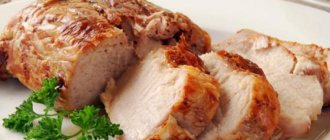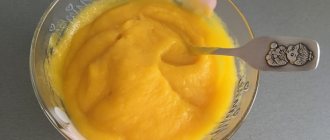Your baby has just celebrated his first “anniversary” - he turned one year old. He has learned a lot this year. Should his eating style now change?
Perhaps we can say that your baby has entered a transitional stage in nutrition. He is no longer a baby now. The baby will become more and more familiar with the “food environment” and will become closer to adults in his eating habits and preferences. But it takes some time for the baby to gradually adapt to a new style of eating.
By this age, great changes have also occurred in the baby’s digestive system. Firstly, he has already acquired his own teeth. As a rule, by the age of 1 year, children have 6-10 milk teeth. The baby's chewing skills are rapidly improving. In this process, an important role is played by the interest in chewing food, which “gets” to the baby in coarsely crushed or even uncrushed form. Secondly, the activity of digestive enzymes produced in various parts of the baby’s digestive tract has increased significantly. This means that he is already ready to digest and assimilate much more complex foods than six months ago. Thirdly, the child has already become acquainted with many tastes of dishes; it is likely that he has already formed certain taste preferences. Further modification of nutrition should be associated not only with an increase in the nutritional value of the diet, but also with the expansion of the baby’s taste knowledge.
As a rule, breastfeeding after 1 year occurs early in the morning and late in the evening, before bedtime. Night feedings often continue at this age. There is nothing wrong with this: it is impossible to overfeed with breast milk. In addition, recent studies allow us to say with confidence that night breastfeeding not only does not increase the risk of developing caries, but, on the contrary, prevents its development. Antibodies contained in breast milk inhibit the growth of staphylococcus, which is the main cause of caries.
If the baby has already stopped receiving breast milk, but continues to “latch on” to a bottle of formula or even juice at night, then this needs to be stopped. Unfortunately, formulas differ in properties from breast milk. Therefore, their consumption, especially at night, significantly increases the risk of developing caries. The fact is that after them, as after any meal, the acid-base balance in the oral cavity strongly shifts to the acidic side, which creates the preconditions for the destruction of tooth enamel. And in general, by the age of one and a half years, a baby should be weaned from eating at night (this does not apply to breastfeeding), as this disrupts sleep, worsens appetite during the day and does not allow parents to get enough sleep.
When and how much to feed your baby?
Up to 1.5 years old, you can leave your baby five meals a day, but if you notice that the child refuses the last (fifth) feeding, then it’s time to transfer him to the “adult” four meals a day: breakfast, lunch, afternoon snack and dinner.
In this case, the intervals between feedings are 3.5-4 hours. It is during this period, according to research, that the food eaten is evacuated from the baby’s stomach, that is, it is ready for the next meal. You should strictly follow the established diet: try not to deviate from the “schedule” for more than 15-30 minutes. If the feeding regime is observed, the entire digestive system operates more clearly: the food reflex determines the formation of a good appetite, digestive juices are produced in a timely manner and in sufficient quantities, which allows food to be well digested and absorbed. With disordered eating, such a reflex is almost not developed, the secretion of enzymes and juices is reduced, and food is processed worse. Try not to give your baby anything between feedings - fruits, juices, dairy products, and especially sweets. This especially applies to children with decreased appetite. Such “snacks” reduce the baby’s appetite, disrupt the established mechanism for the production of digestive juices, so during main meals he may refuse certain healthy foods. The calorie content of a child's daily diet at 12-18 months is approximately 1300 kcal, the volume of food is 1000-1200 ml.
The distribution of this amount throughout the day is quite even: breakfast and dinner - 25% each, lunch - 35%, afternoon snack - 15%. It is estimated that for every kilogram of body weight, a one-year-old child needs about 4 g of protein, 4 g of fat and 16 g of carbohydrates per day. In this case, proteins of animal origin should make up at least 70% of their total daily amount, vegetable fats - approximately 13% of the total amount of fat.
Basic rules for eating
Should I give water to my baby or not?
There are rules about how often to feed a one-year-old baby. There should be 4-5 meals a day. It is advisable not to allow any snacks.
By the age of one year, children already have teeth. Their number may vary, these are normal variants. Some have already acquired 4 teeth or more and continue to grow, while others are just beginning to emerge. In this regard, food should have a mushy consistency with the presence of lumps. Porridges are served pureed, vegetables and fruits are served as purees, meat, poultry and fish are served as soft minced meat.
The child is eating
You can add foods that are not pureed, but crushed into very small pieces, to encourage the baby to practice chewing and get used to this process. Those children whose first molars have erupted can be offered pieces of food about 2-3 cm in size.
At this age, children develop taste preferences in food, so it is important to offer children new dishes and introduce them to other tastes. It is necessary to introduce new products gradually, observing the reaction in digestion, and also checking whether an allergic reaction occurs.
What to serve?
By the age of 1, your baby has most likely become familiar with almost all types of foods. After 1 year, modifying the diet involves both turning to new products and gradually changing the method of their preparation and the degree of grinding.
Breast or not breast? Despite the fact that the baby has formally already left the ranks of infants, it is perhaps still too early to wean him, especially in the hot season (the latter circumstance significantly increases the risk of catching an intestinal infection). Many pediatricians believe that breastfeeding is worth it until about 20-24 months. After all, sucking the breast not only gives the baby the opportunity to receive tasty milk, but also allows you to feel maternal warmth and care, providing psychological comfort. We must also not forget that milk remains extremely useful at this age: it contains special substances that stimulate the development of the nervous system, in particular the brain, many vitamins, antibodies, and is easily and completely absorbed.
What drinks can a one-year-old child eat?
Hypoallergenic formulas for newborns
In addition to new food products, a 1-year-old child’s menu includes various drinks. Among them are cow or goat milk, tea, fruit drinks, compotes, juices, jelly.
Child drinks milk
Important! Sweet carbonated drinks, coffee and kvass are strictly prohibited.
After a year, the risk of getting an allergic reaction to cow's milk components decreases. Therefore, when breastfeeding is completed, cow's milk can replace it in the diet. Goat's milk is given to a child if an allergy to cow's milk is detected. For those babies who were bottle-fed, the transition will be smoother.
Note! A cow's body may contain antibiotics, and goat's milk loses most of its nutrients during heat treatment.
Herbal tea in special packages can be given to children up to one year old. Teas come in different compositions; they are given in the morning or before bed, as well as to soothe a child’s tummy or as a means to boost immunity. Black tea contains caffeine, so it is best to offer it to your baby in the morning at breakfast. Tea should be diluted, not strong, without flavorings or additives. You can add milk to it.
For fruit drinks from berries, cranberries, black currants, sea buckthorn, raspberries, and strawberries are used. Sugar is added if the berries are too sour. Fruit drinks should be given to a child with caution if there is no confidence in the quality of the water or berries, since no heat treatment is carried out during preparation.
You can cook compotes for a child up to a year. Depending on the season, compotes are made from fresh and juicy fruits and berries or from dried fruits. Summer fruits and berries - apples, pears, gooseberries, cherries - remove toxins and metals from the body. Dried fruits suitable for compote are raisins, dried apricots, prunes, dates. Each of them has benefits for digestion and the body as a whole: strengthening the immune system and tooth enamel, improving the functioning of the nervous system and heart. You should not give dried fruits a lot and often, this can lead to diarrhea. Compote made from such ingredients turns out sweet, so adding sugar or fructose is not required.
Additional Information. Dried fruits must be bought in supermarkets and always in packaging. You should choose those that are not bright in color and do not contain dyes, preservatives or other harmful additives.
Dried fruits for compote
Kissel can be made from berries, jam or milk. Suitable berries include cranberries, cherries and blueberries. The jelly is supplemented with oatmeal, sugar, and starch. Their content explains the high calorie content of the product. As a result, jelly is recommended for those who are underweight.
Dairy products in child nutrition
Dairy products still occupy a large place in the diet. They are a source of valuable calcium, B vitamins, as well as a supplier of protein and milk fat. After 1 year, the baby can be offered kefir (up to 200 ml per day), yogurt (200-300 ml). It is better not to exceed the recommended amount, since lactic acid products are rich in acidic compounds, which can overload both the baby’s digestive and excretory systems. It is better that the yogurt is made specifically for baby food. If you give your baby “adult” yogurts, make sure that they are low-fat (milk, not creamy) and contain as little sucrose, preservatives, flavors and other artificial additives as possible. Of course, it is better to prefer “live” yoghurts - they allow you to maintain healthy intestinal flora. Such yoghurts have a limited shelf life (usually no more than 2 weeks), and they can only be stored in the refrigerator, at a temperature of 2-8°C. If the yogurt packaging indicates that the shelf life exceeds 1 month, then this product has been heat-treated and does not contain live lactic acid cultures. Also relevant are milk formulas - the so-called “follow-up formulas”, that is, those intended for feeding children after 6 months. Why is it worth offering them to your baby even after 1 year? The fact is that nutritionists increasingly agree on postponing a baby’s introduction to whole cow’s milk until at least 2-2.5 years of age, which is associated with a high frequency of allergic reactions to cow’s milk protein.
Other important dairy products are cottage cheese and cheese. The daily dose of cottage cheese can be increased to 70 g per day after 1 year. Some parents prefer to give it to their children every other day, but in a dose of about 140 g. Cottage cheese can be given in its “pure” form, or you can make pudding, casserole from it, or make cheesecakes when closer to a year and a half. Cheese is more often used in grated form as an additive to pasta. But some kids love to chew cheese with their teeth. In this case, this product will also contribute to the development of chewing skills.
Butter is most often used as an additive to cereals or spread on bread. The recommended dose is about 12 g per day. It is better not to heat-treat butter (that is, add it to ready-made dishes).
After 1 year, you can use low-fat sour cream and cream in small quantities. Sour cream is best suited for seasoning first courses, cream is best for preparing sauces for second courses.
Cereal dishes
After a year, both gluten-free cereals (buckwheat, rice and corn) and gluten-containing cereals (wheat, oats, rye) are used in children’s diets. Cereals are consumed both in the form of porridges and as cereal side dishes for main courses. Buckwheat, corn and oatmeal porridges, and multi-grain porridges will be especially beneficial for children.
After a year, you can gradually add semolina and millet porridge to your child’s menu, but semolina should be given infrequently - it is very high in calories. Porridges are usually served for breakfast and their quantity is no more than 200-250 ml. The volume of side dish for main courses should be about 100-150g.
Fruits and vegetables in a child's diet
Fruits and vegetables should also be widely represented on the baby’s table. After 1 year, you can slowly introduce the baby to new types of fruits and berries: strawberries, cherries, sweet cherries, kiwis, apricots, peaches, currants, gooseberries, chokeberries, sea buckthorn, raspberries, blackberries, cranberries, blueberries, lingonberries and even citrus fruits. Of course, such introductions should be well thought out, and the mother will have to carefully monitor the baby’s reaction to each new product introduced. In children with allergic reactions, it is better not to take new steps without consulting an allergist or pediatrician. Berries that have a fairly dense peel are best crushed into puree, while soft, juicy fruits (apricots, peaches, kiwi) can be offered to the baby in slices. Even if your beloved toddler tolerates exotic fruits (citrus fruits, kiwi) well, do not give them a lot: these fruits contain quite a lot of plant acids, which in large quantities can irritate the delicate mucous membrane of the gastrointestinal tract. Grapes enhance fermentation processes in the intestines and overload the child’s diet with carbohydrates. However, it is relatively poor in vitamins. That's why nutritionists recommend starting to use it at a later age - closer to three years. Fruits can be given to the baby at the end of main meals; they can also be added to porridge or mixed with dairy products. The recommended dose of fruit is about 200-250 g per day. You can add another 100 ml of fruit juice to this amount. If before 1 year you should prefer clarified juices, then after 1 year it is quite possible to give the baby juices and nectars with pulp.
The baby’s vegetable menu can be enriched with beets, turnips, tomatoes, green peas, and beans. Legumes should be given to children in small quantities and only in well-cooked and thoroughly crushed form, since these products are rich in coarse fiber, which causes increased gas formation in the intestines and increases peristalsis, which can lead to abdominal pain and diluted stools. Vegetables are mainly used in soups and side dishes for meat and fish dishes. They can not only be boiled, but also stewed. At the age of 1 year, they are given in the form of purees; closer to one and a half years, you can begin to offer your baby soft boiled or stewed vegetables in pieces. Closer to one and a half years, you can sometimes start offering your baby garden greens - dill, parsley, cilantro, wild garlic, spinach, lettuce, green onions. Finely chopped greens can be added to soups and main courses before serving.
It is better to add vegetable oils at the final stage of cooking vegetables in order to expose them to heat as little as possible, since in the process of heating any fats, carcinogens are formed that are harmful to the health of not only infants, but even adults.
Advertising
Regional Children's Consultative and Diagnostic Clinic
The most complete type of nutrition for a child of the first year of life is maternal feeding.
milk. Breastfeeding is both an important spiritual contact between mother and child, and a full biological impact on it.
Rational feeding of children has a significant impact on the vital functions of a growing organism, ensures its resistance to various environmental factors, and underlies the prevention of most diseases at any age.
Breastfeeding is the only type of food that is fully adapted to the limited capabilities of the infant’s digestive functions, and an important factor in the adaptation of newborns to new conditions of intrauterine existence.
Feeding an infant with human milk is considered the “gold standard” for optimal nutrition of a child in the first year of life.
- Breast milk has an optimal composition in terms of quantity and quality of proteins, fats, carbohydrates, vitamins and minerals, which is necessary to ensure the intensive growth of a child with an immature digestive system.
- Breast milk has unique protective properties against bacterial and viral infections.
- Breast milk prevents the occurrence of allergies, since it does not have a sensitizing effect and promotes the formation of immunological tolerance (resistance) to antigens of food products consumed by the mother.
- Ensuring adequate eating behavior.
- Ensuring the correct anatomical formation of the dentofacial system, the cerebral part of the skull, as well as the sound reproduction apparatus due to the emergence of forces and tensions during the baby's sucking of the mother's breast that most adequately regulate these processes.
- Skin-tactile and emotional contacts between mother and child are extremely important for the normal physical and mental development of the child
According to WHO, adults who received mother's milk in childhood are less likely to develop diabetes, atherosclerosis, cancer, and blood diseases.
If the mother has enough breast milk, then feeding only breast milk should be carried out for up to 6 months, and then, with the introduction of complementary foods, breastfeeding can continue for up to a year or even up to two years, with a constant decrease in the volume of its consumption by the child - this is called natural feeding.
The introduction of complementary feeding is due to the fact that after a certain time, breast milk alone becomes insufficient to fully satisfy the child’s needs for energy, proteins, iron and other nutrients.
If the mother has little breast milk, then for the full growth and development of the child it is supplemented with baby adapted milk formulas (supplementary feeding). This is called mixed feeding.
It is important to know that the mother should not independently decide on supplementing her baby with adapted or partially adapted milk formulas if insufficient lactation is suspected.
This must be decided by the pediatrician based on specific objective data (for example, insufficient weight gain of the child in a month, etc.).
If for some reason the mother does not feed the baby breast milk at all, then he is forced to switch to artificial feeding, receiving only adapted milk formulas for up to 4 months, and then gradually can receive adapted formulas and complementary feeding products.
The most adapted human milk substitutes recommended for mixed feeding include the liquid formula “Agusha 1” (sterilized fresh and fermented milk), dry formulas “Nutrilak 1”, “Nutrilon 1”, “Baby 1”, “HIPP 1”, “ NAN" and "NAN 1", "Malyutka", as well as milk formulas enriched with nucleotides - "Similac Formula Plus", "Frisolak 1 Gold", and many others.
It should be remembered that although adapted milk formulas are close in composition to human milk, they, nevertheless, are not its complete analogue.
For feeding children from 5-6 months, so-called subsequent formulas are used, which are partially adapted to human milk, which is completely justified in the second half of the child’s life.
The following mixtures include the liquid mixture "Agusha 2" (fresh and fermented milk) and dry mixtures "Nutrilon 2", "Humana 2", "Heinz" for children over 6 months, "Frisolak 2" "Gold", "NAN" with 6 to 12 months and many others.
There are certain rules for introducing food to young children.
One of the first introductions of complementary foods is vegetable puree (from 4.5-5.5 months) or milk porridge, which are introduced no earlier than 5.5-6.5 months. child's life. Vegetable puree or milk porridge must be introduced gradually. These dishes are thicker and therefore unusual for the child. They must be thoroughly crushed (pureed) and form a semi-liquid homogeneous mass. You cannot introduce 2 or more new dishes into your diet at the same time. You should switch to another type of food only when the child is completely accustomed to the previous one.
To prepare vegetable puree, you can use a variety of vegetables - potatoes, carrots, cauliflower, pumpkin, zucchini, green peas, spinach, etc. Their combinations are preferable, and potatoes should not make up more than half of the total volume of the dish.
First, it is better to give pureed zucchini, squash, cauliflower, broccoli, then carrots, potatoes, pumpkin, and later include other vegetables listed. Vegetables for making puree should be steamed with a small amount of water under the lid, then wiped with the addition of hot milk or water, vegetable oil and butter (starting from 1 g, increasing to 3 g, and then to 6 g). For complementary feeding, you can also use ready-made vegetable purees produced by the industry for baby food.
To prepare porridges, it is recommended to use buckwheat, rice, or oatmeal cereals or flour. When using rice-based cereals, babies are less likely to experience regurgitation and various negative effects from the gastrointestinal tract. To prepare cereal porridges, they are first boiled in water, then milk is added, which should not be subjected to prolonged boiling. Oil should be added to already prepared porridge. If necessary, porridge can be cooked with vegetable broth.
As complementary foods, you can use ready-made dry milk and dairy-free porridges, including quick-cooking ones, industrially produced quick-cooking flour (for example, buckwheat), fortified with vitamins and iron.
You can add the yolk of a chicken egg to the porridge or give it to your child separately. To do this, remove the yolk from a hard-boiled egg, grind it with breast milk or an adapted formula and give it to the child, starting with 2-3 grams, subsequently increasing to a quarter or half of the yolk per day. A new dish should be started with 5-10g, reaching the required amount in 10-15 days (see the feeding schedule).
It is recommended to introduce fruit juices, starting with drops, then 0.5-1 teaspoon, gradually increasing to the required amount in accordance with age.
After 2 weeks of drinking fruit juice, you can also gradually introduce fruit puree. Juices and fruit purees are important for supplementing dairy nutrition with vitamins C, carotene, flavonoids, folates (vitamin B9), minerals, sugars, and delicate dietary fiber. In this case, juices and purees should be introduced into the child’s diet no earlier than 5-6 months of age.
Natural apple juice from green varieties of apples is recommended as the first fruit component, then plum and pear juice.
In the nutrition of children in the first year of life, it is recommended to widely use ready-made juices and purees produced by industry specifically for baby food (domestic and imported). There are fruit purees that are homogenized (for children 3.5-5 months) and pureed (for children 6 months and older), as well as with pulp, which are richer in dietary fiber, potassium, iron, and vitamins. They are recommended for use in children starting from 6-8 months of age.
Citrus juices, as well as raspberry, strawberry, and tomato juices, which can cause allergic reactions in a child, are not recommended as complementary foods. You should not use grape juice, which contains a lot of sugar and can cause fermentation in the intestines.
From 5-6 months you can include cottage cheese in children’s diet, from 6-7 months. – crackers, chicken egg yolk, from 7.5-8 months. – meat puree, fermented milk products or milk, from 8 months. – a small amount of bread, from 8-9 months. – fish (if the child is not at risk for allergies).
With the introduction of complementary foods from 4.5-5.5 months. it should include vegetable and butter, starting from 1-3 g per day, increasing to 6 g of both types of fatty products by the year.
Over time, when switching to denser foods, the child’s need to drink increases - on average 100-120 ml per day, and more on hot days. Drinks should be given between feedings, for example, rosehip decoction, fruit decoction, weak tea, and green tea in hot weather.
Liquid fermented milk products (preferably baby kefir) or milk (preferably baby milk) with crackers or cookies (biscuits, etc.) can be introduced into the diet of children 7.5-8 months of age. At the same feeding, it is advisable to give cottage cheese or a curd product with fruit or vegetable fillings (preferably children's curd "Agusha", "Tema") and fruit puree.
Introduction of meat products into the diet of children of the first year of life
After vegetable puree and porridge, the next complementary feeding from 6-7 months is meat puree, which can gradually be supplemented with meat soufflé, steamed meatballs, then steamed cutlets. From 8 months, broth is introduced to form lunch. Lean meat can alternate with lean chicken, from 8-9 months - 1-2 times a week.. It is recommended to include the following types of meat products in the diets of children of the first year of life: lean beef, pork, lamb, veal, offal. Meat and fish purees go well with vegetable purees. Whole cow's milk can be used in the nutrition of children of the first year of life only for preparing cereals in a volume of no more than 200 ml per day! Cow's milk is contraindicated in children with lactase deficiency. It is better to talk to your pediatrician in advance about introducing cow's milk into your child's diet.
It is good to use industrially produced meat and fish, as well as industrially produced meat and vegetables, meat and cereals, especially for baby food. Canned meat is produced in homogenized form (for younger children) and in finely ground form (for older children).
A month after introducing meat puree into the child’s diet, meat complementary foods can be replaced with lean fish (cod, pike perch, hake) in the form of minced meat.
Fish is a very healthy product, as it contains easily digestible protein and is rich in phosphorus, which, together with calcium, is involved in the construction of bone tissue. Fish is also rich in vitamins A, D, B6, B12, and pantothenic acid.
It should be borne in mind that fish can cause allergies, so it is administered with caution and with the permission of the pediatrician.
Summarizing the above, we would like to give some general advice on organizing nutrition for children in the first year of life, following which will help preserve and increase their health:
-Remember that the best food for a baby is breast milk. Breastfeeding can be continued until the child is two years old, but it is especially important until the child is 6 months old;
-breast milk best satisfies the baby’s need for energy and nutrients, builds the child’s immunity, provides protection against germs and improves the psychological connection between mother and baby;
- in order for there to be enough breast milk to feed the baby, the mother’s fluid intake should be increased through milk and fermented milk drinks, juices (preferably apple, pear, plum, cherry), compote, green tea, but not carbonated water and sweet soft drinks;
- if the child is not breastfed, then his nutrition should still correspond to the age-related physiological needs for nutrients and energy. To do this, you need to use adapted milk and fermented milk mixtures, and after 6 months - partially adapted (“subsequent”) mixtures of domestic and imported production.
From 4 months, children should receive complementary feeding products produced by the food industry (fruit juices, fruit purees, milk porridges, meat purees, children's cottage cheese), yolk, cookies, crackers, children's fermented milk products, bread in strict accordance with the recommended timing of their introduction and volumes servings. The introduction of a new product or dish begins with 1-5 ml/g, gradually increasing to the required amount over two weeks. You cannot introduce two or more new products or dishes at the same time.
The child’s diet should not include (no matter how much the mother and especially grandparents would like it) cakes, pastries, and especially chocolates. If you really want to pamper your baby with something sweet, choose marshmallows, jam, preserves (it’s better if the marmalade contains fructose). Be sure to follow the rules for introducing new products, keep an eye on the freshness of the food and the cleanliness of your baby’s dishes (as well as his and your hands) to avoid intestinal infections. And remember the basic rules: a baby aged one to one and a half years eats four or five times a day, that is, with a break between feedings of about 4 hours.
Try to follow the diet strictly enough so that the child develops a conditioned reflex (that is, by a certain time the digestive system will be ready to accept and digest food). The calorie content of meals is different: lunch should be the most calorie-rich, then in descending order – dinner, breakfast, afternoon snack. The daily amount of food (not counting liquid) is 1000 – 1200 ml (such recommendations last for about one and a half years). Gastroenterologist Velikodchenko A.A.
Meat, fish, eggs in child nutrition
Meat products are given in the form of steam cutlets, meatballs, meatballs, meat soufflé and pudding in the amount of 100 g daily. Towards the middle of the second year, you can offer your baby stewed meat in small pieces, but at the same time be careful that he does not choke. Many types of meat are still used in the diet: beef, veal, lean pork, rabbit, turkey, chicken, as well as offal - liver, tongue, heart, brains. Waterfowl meat (duck, goose) and lamb are rich in refractory fats, which complicates the digestion and absorption of these types of meat, so they can be given only from time to time.
Fish should be offered once or twice a week, 30-40 g per meal, as a replacement for meat dishes. You can prepare fish cutlets (steamed) or meatballs, or stew fish fillets.
Eggs are also of great importance in the nutrition of children after 1 year, as they are rich in valuable nutrients - easily digestible protein, valuable amino acids, vitamins (A, D, E), phospholipids, minerals, micro- and macroelements. Egg whites are absorbed almost completely - 96-97%, fats - about 95%. Only chicken and quail eggs are used to feed babies. Waterfowl eggs are excluded due to the high risk of transmitting dangerous infections. Quail eggs differ from chicken eggs not only in their higher protein content (with a large amount of the essential amino acid tryptophan), but also in their higher fat and cholesterol content. Children under 1.5 years old should only be offered eggs boiled (hard-boiled) or in the form of omelettes with milk (they can also contain various vegetables). In their raw form (and in addition, “soft-boiled” and “in a bag”, eggs are less digestible, since they contain undenatured protein, and are also dangerous from the point of view of transmitting infections. It is convenient to cook an omelet in the microwave. Then it will not be fried, as in frying pan, and baked, without crust. The omelet mass is poured into a bowl designed for microwave ovens (without using oil) and placed in the oven for 2-3 minutes. In addition, eggs are added to other products during the preparation of various dishes (cheesecakes, pancakes etc.). Since eggs are a product with high allergenic properties (quail eggs are still much less allergenic than chicken eggs), they should not be given to children daily, it is better to do this 3 times a week or every other day. The recommended dose of eggs is % chicken eggs per day or whole eggs every other day.For quail eggs, the dose is approximately doubled.
Basic dietary requirements
When asked by parents about what to feed a year-old child, Dr. Komarovsky answers that babies can be offered dishes from an adult table, following reasonable rules: the food should be slightly under-salted, without a lot of fat and spices. It’s not worth switching completely to the adult table yet, but adjusting the child’s menu to the general one makes sense.
The menu of a one-year-old child should include many healthy products and a variety of dishes that are prepared from them. For full development, it is necessary to maintain a balance between proteins, fats and carbohydrates. Parents should not forget about vitamins and minerals.
Nutrition for a 1 year old child should be based on foods high in animal protein. You should definitely include them in your daily diet. Products that are high in protein include meat, poultry, fish, eggs, milk, yogurt, cream, cottage cheese, sour cream, cheese, kefir.
Cheese, cottage cheese, cream and sour cream are sources of calcium; their high fat content for a child’s stomach allows them to be given to the child once every two to three days. They are present on the table in small quantities:
- Cheese – 5 g.,
- Cottage cheese – 50 g.,
- Cream and sour cream – 10 g.
Milk, kefir or yogurt should be given to children every day in a total amount of 500 ml. If these items are part of another prepared dish, they are still counted and included in the total. Fermented milk products are necessarily included in the diet. They are important for proper bowel function. Cereals, vegetables and fruits are also given every day:
- Porridge – 200 ml,
- Fruits – 200 ml,
- Vegetables – 300 ml.
You should combine dishes from vegetables and meat, poultry or fish, eggs, cheese and bread, cottage cheese and fruits, milk, kefir and cereals. It is worth serving fatty foods together with low-fat ones, for example, cream with fruit puree or cheese with a slice of bread. How much can a child eat of these foods per day:
- Egg – 50 g.,
- Bread – 40 g.,
- Meat – 75 g.,
- Fish – 30 g.,
- Sugar – 20 g.
Vegetable oil can be given only 5 ml per day. It is permissible to use butter in an amount of 20 g per day.
Cereals, flour and bakery products in a child’s diet
Cereals are widely used in baby food. Oatmeal and buckwheat are especially useful for babies; you can also use corn, rice, millet and other types of cereals. It will be easier for a one-year-old baby to chew and swallow if the porridge has a uniform consistency, which is why soluble (“instant”) porridges are often used. Closer to one and a half years, you can give well-cooked cereals without additional grinding.
From time to time, pasta can be used in children's meals. They can be given as a side dish or seasoned with soup. However, they should not be abused, as they are rich in easily digestible carbohydrates. It is recommended to offer them to your baby once or twice a week.
Bread is also used in the nutrition of children of this age. Up to 1.5 years, it is better to offer babies only white bread: it is easier to digest. The total amount of bread per day should not exceed 100 g. Starting from 1.5 years, you can include a little rye bread in the diet of crumbs (up to 50 g per day). Children under 1.5 years old are not offered rye bread, since the sour dough from which it is made causes fermentation in the intestines.
Advertising
How to introduce new components
Regardless of whether the toddler is breastfed or bottle-fed, the rules for complementary feeding are always the same:
- novelty in nutrition is practiced only on healthy children who have normal stools;
- if the baby’s living conditions change (for example, moving), the period of complementary feeding is shifted to a later time;
- It is recommended to give the first vegetable purees in the 2nd feeding;
- start with small quantities (1 tsp each), with a gradual increase to 150 ml;
- Give complementary foods before the main feeding and always in a warm form.
When the baby gets used to one type of vegetable, the next product is introduced into the menu (not excluding what has already been mastered).
Important! For children receiving food through a tube, the menu and food calculations are drawn up by the attending physician.
Having discovered that the baby is allergic to some component, he is removed from the diet, and after 2-3 days the attempt is repeated. If the reaction occurs again, the new product is completely excluded from the menu.
The monthly nutritional norm for infants should become the main rule for the mother in the physiological development of the child. This will allow you to distribute the products, creating a balanced menu. Knowing how much the baby should eat per day, it is easier to determine a single dose of food. Thanks to this, the stomach will not be overloaded, and the little one will begin to gain weight normally.
How to determine if a child is eating enough?
For each year of the child there should be approximately one tablespoon of each type of food. Offer your baby beautifully decorated and delicious food. See how much he will eat without your coaxing or any pressure. Don't force your child to eat everything you serve him. Let him eat as much as he deems necessary to satisfy his hunger. If after eating the child is still hungry, then offer him to eat more.
Don’t threaten or punish your child if he doesn’t want to eat—don’t force him! Do not resort to bribery, offering watching cartoons or dessert as a reward - just to shove at least another spoon into your beloved child.
Do not show your child your concern about his refusal to eat. Sensitively sensing your mood on this matter, children may refuse to eat in order to attract attention to their person from their parents.
Persistently feeding a baby while listening to fairy tales or songs, using threats or persuasion can lead to the fact that in adulthood the child will not be able to determine the level of satiety when hunger has already been satisfied. This behavior quickly leads to excess weight gain and all the health problems that come with it.
Sample menu for a baby
The menu for a one-year-old child may look like this:
- For breakfast:
- Buckwheat porridge – 200 g;
- White bread – 10 g;
- Butter – 5 g;
- Tea with milk – 70 g.
- For lunch:
- Zucchini soup – 100 g;
- Chicken cutlet – 50 g;
- Mashed potatoes – 100 g;
- Apple compote – 50 g.
- For afternoon tea:
- Baked apple – 100 g;
- Kefir or milk – 100 g;
- Cookies – 15 g.
- For dinner:
- Boiled egg – 50 g;
- Kissel – 100 g;
- Cheesecakes – 100 g.











